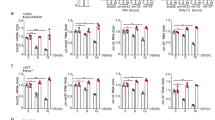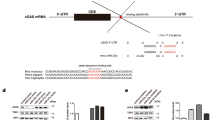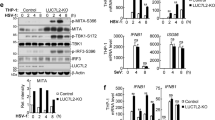Abstract
Effective recognition of viral infections and subsequent triggering of antiviral innate immune responses are essential for the host antiviral defense, which is tightly regulated by multiple regulators, including microRNAs (miRNAs). A previous study showed that miR-466l upregulates IL-10 expression in macrophages by antagonizing RNA-binding protein tristetraprolin-mediated IL-10 mRNA degradation. However, the ability of miR-466l to regulate antiviral immune responses remains unknown. Here, we found that interferon-alpha (IFN-α) expression was repressed in Sendai virus (SeV)- and vesicular stomatitis virus (VSV)-infected macrophages and in dendritic cells transfected with miR-466l expression. Moreover, multiple IFN-α species can be directly targeted by miR-466l through their 3′ untranslated region (3′UTR). This study has demonstrated that miR-466l could directly target IFN-α expression to inhibit host antiviral innate immune response.
This is a preview of subscription content, access via your institution
Access options
Subscribe to this journal
Receive 12 digital issues and online access to articles
$119.00 per year
only $9.92 per issue
Buy this article
- Purchase on Springer Link
- Instant access to full article PDF
Prices may be subject to local taxes which are calculated during checkout





Similar content being viewed by others
References
Barbalat R, Ewald S, Mouchess M, Barton G . Nucleic acid recognition by the innate immune system. Annu Rev Immunol 2011; 29: 185–214.
Beutler B, Eidenschenk C, Crozat K, Imler J, Takeuchi O, Hoffmann J et al. Genetic analysis of resistance to viral infection. Nat Rev Immunol 2007; 7: 753–766.
Takeuchi O, Akira S . MDA5/RIG-I and virus recognition. Curr Opin Immunol 2008; 20: 17–22.
Holm C, Jensen S, Jakobsen M, Cheshenko N, Horan K, Moeller H et al. Virus-cell fusion as a trigger of innate immunity dependent on the adaptor STING. Nat Immunol 2012; 13: 737–743.
Negishi H, Yanai H, Nakajima A, Koshiba R, Atarashi K, Matsuda A et al. Cross-interference of RLR and TLR signaling pathways modulates antibacterial T cell respons. Nat Immunol 2012; 13: 659–666.
Lambrecht B, Hammad H . Lung dendritic cells in respiratory viral infection and asthma: from protection to immunopathology. Annu Rev Immunol 2012; 30: 243–270.
Liu J, Liu S, Cao X . Highlights of the advances in basic immunology in 2011. Cell Mol Immunol 2012; 9: 197–207.
Taniguchi T, Takaoka A . A weak signal for strong responses: interferon-alpha/beta revisited. Nat Rev Mol Cell Biol 2001; 2: 378–386.
Honda K, Takaoka A, Taniguchi T . Type I interferon gene induction by the interferon regulatory factor family of transcription factors. Immunity 2006; 25: 349–360.
Herdy B, Jaramillo M, Svitkin Y, Rosenfeld A, Kobayashi M, Walsh D et al. Translational control of the activation of transcription factor NF-κB and production of type I interferon by phosphorylation of the translation factor eIF4E. Nat Immunol 2012; 13: 543–550.
Cui J, Li Y, Zhu L, Liu D, Song Z, Wang H et al. NLRP4 negatively regulates type I interferon signaling by targeting the kinase TBK1 for degradation via the ubiquitin ligase DTX4. Nat Immunol 2012; 13: 387–395.
Chiba S, Baghdadi M, Akiba H, Yoshiyama H, Kinoshita I, Dosaka-Akita H et al. Tumor-infiltrating DCs suppress nucleic acid-mediated innate immune responses through interactions between the receptor TIM-3 and the alarmin HMGB1. Nat Immunol 2012; 13: 832–842.
Hengel H, Koszinowski U, Conzelmann K . Viruses know it all: new insights into IFN networks. Trends Immunol 2005; 26: 396–401.
Iannello A, Debbeche O, Martin E, Attalah L, Samarani S, Ahmad A . Viral strategies for evading antiviral cellular immune responses of the host. J Leukoc Biol 2006; 79: 16–35.
O'Connell R, Rao D, Chaudhuri A, Baltimore D . Physiological and pathological roles for microRNAs in the immune system. Nat Rev Immunol 2010; 10: 111–122.
Lindsay M . microRNAs and the immune response. Trends Immunol 2008; 29: 343–351.
Bushati N, Cohen S . MicroRNA functions. Annu Rev Cell Dev Biol 2007; 23: 175–205.
O'Connell R, Rao D, Baltimore D . microRNA regulation of inflammatory responses. Annu Rev Immunol 2012; 30: 295–312.
Wang P, Gu Y, Zhang Q, Han Y, Hou J, Lin L et al. Identification of resting and type I IFN-activated human NK cell miRNomes reveals microRNA-378 and microRNA-30e as negative regulators of NK cell cytotoxicity. J Immunol 2012; 189: 211–221.
Bai Y, Qian C, Qian L, Ma F, Hou J, Chen Y et al. Integrin CD11b negatively regulates TLR9-triggered dendritic cell cross-priming by upregulating microRNA-146a. J Immunol 2012; 188: 5293–5302.
Liu Y, Chen Q, Song Y, Lai L, Wang J, Yu H et al. MicroRNA-98 negatively regulates IL-10 production and endotoxin tolerance in macrophages after LPS stimulation. FEBS Lett 2011; 585: 1963–1968.
Hou J, Wang P, Lin L, Liu X, Ma F, An H et al. MicroRNA-146a feedback inhibits RIG-I-dependent Type I IFN production in macrophages by targeting TRAF6, IRAK1, and IRAK2. J Immunol 2009; 183: 2150–2158.
Wang P, Hou J, Lin L, Wang C, Liu X, Li D et al. Inducible microRNA-155 feedback promotes type I IFN signaling in antiviral innate immunity by targeting suppressor of cytokine signaling 1. J Immunol 2010; 185: 6226–6233.
O'Neill L, Sheedy F, McCoy C . MicroRNAs: the fine-tuners of Toll-like receptor signalling. Nat Rev Immunol 2011; 11: 163–175.
Calabrese J, Seila A, Yeo G, Sharp P . RNA sequence analysis defines Dicer's role in mouse embryonic stem cells. Proc Natl Acad Sci 2007; 104: 18097–18102.
Ma F, Liu X, Li D, Wang P, Li N, Lu L et al. MicroRNA-466l upregulates IL-10 expression in TLR-triggered macrophages by antagonizing RNA-binding protein tristetraprolin-mediated IL-10 mRNA degradation. J Immunol 2010; 184: 6053–6059.
Hou J, Lin L, Zhou W, Wang Z, Ding G, Dong Q et al. Identification of miRNomes in human liver and hepatocellular carcinoma reveals miR-199a/b-3p as therapeutic target for hepatocellular carcinoma. Cancer Cell 2011; 19: 232–243.
Liu X, Zhan Z, Li D, Xu L, Ma F, Zhang P et al. Intracellular MHC class II molecules promote TLR-triggered innate immune responses by maintaining Btk activation. Nat Immunol 2011; 12: 416–424.
Xu S, Liu X, Bao Y, Zhu X, Han C, Zhang P et al. Constitutive MHC class I molecules negatively regulate TLR-triggered inflammatory responses via the Fps-SHP-2 pathway. Nat Immunol 2012; 13: 551–559.
Han C, Jin J, Xu S, Liu H, Li N, Cao X . Integrin CD11b negatively regulates TLR-triggered inflammatory response by activating Syk and promoting MyD88 and TRIF degradation via cbl-b. Nat Immunol 2010; 11: 734–742.
An H, Hou J, Zhou J, Zhao W, Xu H, Zheng Y et al. Phosphatase SHP-1 promotes TLR- and RIG-I-activated production of type I interferon by inhibiting the kinase IRAK1. Nat Immunol 2008; 9: 542–550.
Karaghiosoff M, Steinborn R, Kovarik P, Kriegshäuser G, Baccarini M, Donabauer B et al. Central role for type I interferons and Tyk2 in lipopolysaccharide-induced endotoxin shock. Nat Immunol 2003; 4: 471–477.
Sakaguchi S, Negishi H, Asagiri M, Nakajima C, Mizutani T, Takaoka A et al. Essential role of IRF-3 in lipopolysaccharide-induced interferon-beta gene expression and endotoxin shock. Biochem Biophys Res Commun 2003; 306: 860–866.
Livak K, Schmittgen T . Analysis of relative gene expression data using real-time quantitative PCR and the 2−ΔΔCt method. Methods 2001; 25: 402–408.
Gottwein E, Mukherjee N, Sachse C, Frenzel C, Majoros W, Chi J . A viral microRNA functions as an orthologue of cellular miR-155. Nature 2007; 450: 1096–1099.
Karageorgas T, Tseronis D, Mavragani C . Activation of type I interferon pathway in systemic lupus erythematosus: association with distinct clinical phenotypes. J Biomed Biotechnol 2011; 2011: 273907.
Ma F, Xu S, Liu X, Zhang Q, Xu X, Liu M et al. The microRNA miR-29 controls innate and adaptive immune responses to intracellular bacterial infection by targeting interferon-γ. Nat Immunol 2011; 12: 861–869.
Selbach M, Schwanhäusser B, Thierfelder N, Fang Z, Khanin R, Rajewsky N . Widespread changes in protein synthesis induced by microRNAs. Nature 2008; 455: 58–63.
Acknowledgements
This work was supported by grants from the National Natural Science Foundation of China (no. 81070880), and the China Postdoctoral Science Foundation funded project number 42201. The authors thank Ms Panpan Ma and Tingting Fang for their excellent technical assistance.
Author information
Authors and Affiliations
Corresponding authors
Ethics declarations
Competing interests
The authors declare no competing financial interests.
Supplementary information
Supplementary information
Supplemental Figure 1 Transfection efficiency of miR-466l. Mouse peritoneal macrophages (a), BMDCs (b) and human THP-1 monocytic cell line (c) were transfected with control mimics or miR-466l mimics using INTERFERin (polyplus transfection). After 24 h, total RNA was extracted and miR-466l was detected using qRT-PCR. The primers for miR-466l were RT primer: 5′-GTC GTA TCC AGT GCA GGG TCC GAG GTA TTC GCA CTG GAT ACG ACA ATA TG-3′; qPCR forward primer: 5′-CGT ATA AAT ACA TGC ACA-3′; qPCR reverse primer: 5′-GTG CAG GGT CCG AGG T-3′. Data are shown as mean±s.d. (n=4) of one representative experiment. Similar results were obtained in three independent experiments. **P<0.01. BMDC, bone marrow-derived dendritic cell. (PDF 96 kb)
Rights and permissions
About this article
Cite this article
Li, Y., Fan, X., He, X. et al. MicroRNA-466l inhibits antiviral innate immune response by targeting interferon-alpha. Cell Mol Immunol 9, 497–502 (2012). https://doi.org/10.1038/cmi.2012.35
Received:
Revised:
Accepted:
Published:
Issue Date:
DOI: https://doi.org/10.1038/cmi.2012.35
Keywords
This article is cited by
-
Type I Interferons in the Pathogenesis and Treatment of Autoimmune Diseases
Clinical Reviews in Allergy & Immunology (2020)
-
Interaction of RNA-binding protein HuR and miR-466i regulates GM-CSF expression
Scientific Reports (2017)
-
MicroRNA miR-466 inhibits Lymphangiogenesis by targeting prospero-related homeobox 1 in the alkali burn corneal injury model
Journal of Biomedical Science (2015)
-
MicroRNAs in the regulation of TLR and RIG-I pathways
Cellular & Molecular Immunology (2013)
-
Regulation of innate receptor pathways by microRNAs
Science China Life Sciences (2013)



